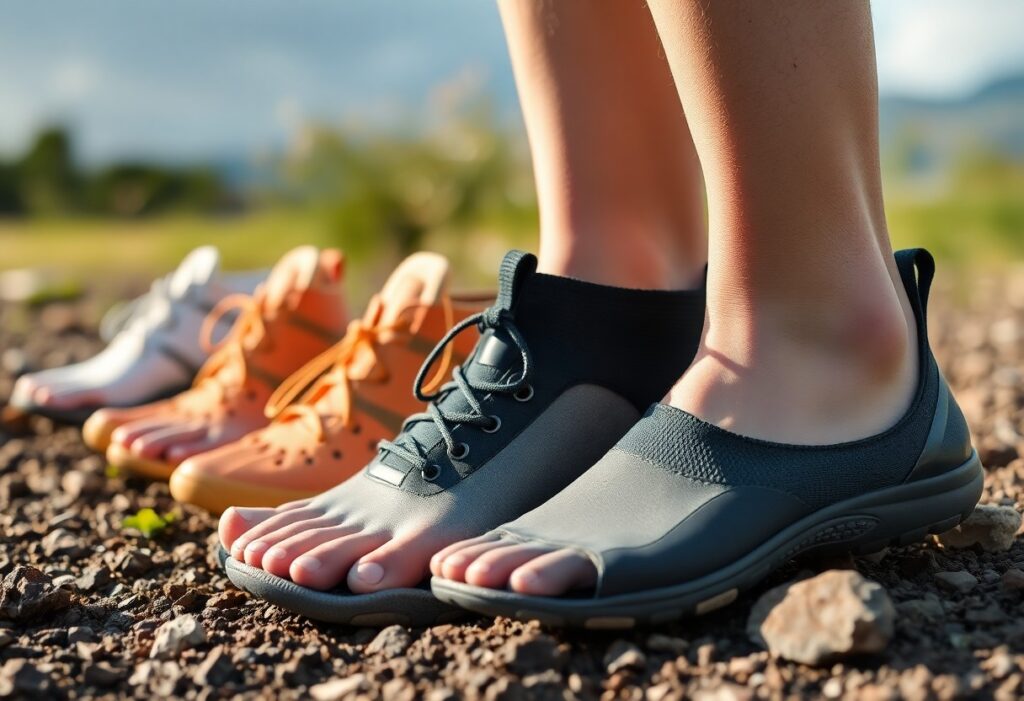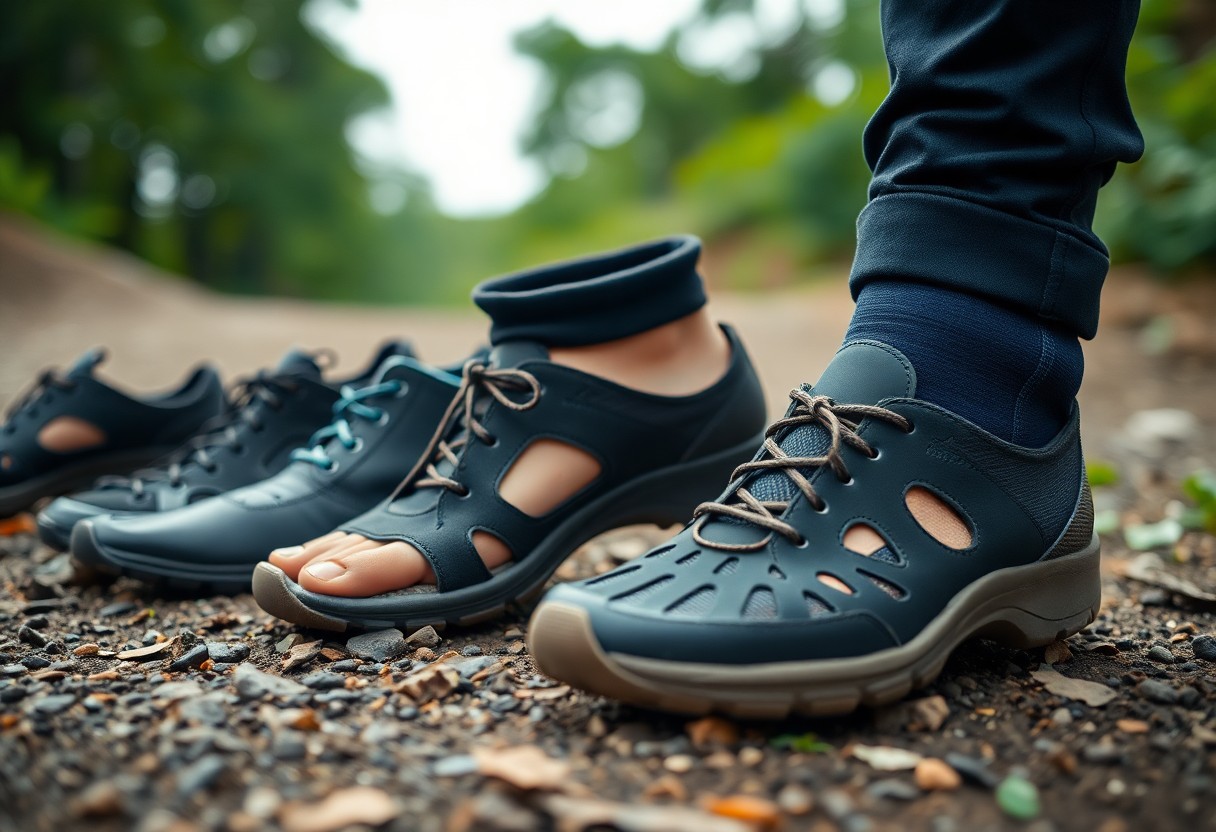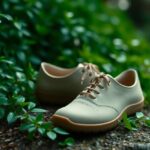
The world of barefoot footwear is undergoing significant evolution thanks to groundbreaking developments in material engineering. These advancements offer users unmatched comfort and performance, revolutionizing the way we think about shoes. This article will delve into how innovative technologies are reshaping shoe design, prominently featuring Vibram soles, which not only enhance ground feel but also provide exceptional protection. As you read on, you will discover various sustainable manufacturing techniques that significantly lower environmental impact while boosting the durability and functionality of barefoot shoes. The integration of biomechanics, advanced materials, and eco-friendly production methods is transforming the minimalist footwear market, paving the way for a future where comfort, performance, and sustainability coexist seamlessly.

Comparing Material Performance: Insights into TPU and EVA
Within the realm of barefoot footwear engineering, two essential materials stand out: Thermoplastic Polyurethane (TPU) and Ethylene-Vinyl Acetate (EVA). Manufacturers conduct in-depth analyses of their molecular structures, thermal properties, and mechanical responses to make informed decisions about their applications. The ongoing discussion revolves around the performance of these polymers under dynamic stress, weight distribution, and different environmental conditions. For instance, TPU is renowned for its exceptional durability, making it ideal for demanding activities, while EVA is cherished for its outstanding cushioning properties, catering to users who prioritize comfort. Each material possesses unique characteristics, allowing them to meet diverse user preferences and performance requirements.
Evaluating Flexibility: Determining the Superior Material
Flexibility plays a vital role in the design of barefoot shoes, as the responsiveness of the material greatly influences the overall user experience. TPU demonstrates superior flexibility at lower temperatures, retaining its structural integrity across a wider range of environmental conditions compared to traditional EVA compounds. This adaptability ensures that wearers can enjoy optimal comfort and responsiveness, regardless of the climate or terrain they encounter, significantly enhancing their overall experience with the footwear.
| Material Property Comparison | Performance Metric |
|---|---|
| TPU Flexibility Range | -40°C to 80°C |
| EVA Flexibility Range | -20°C to 60°C |
Investigating Abrasion Resistance: Key Insights from Taber Test Results
The abrasion resistance of a material is critical for ensuring the longevity and optimal performance of footwear. Taber test results have highlighted the exceptional wear characteristics of TPU, showing significantly lower mass loss percentages when compared to traditional EVA formulations. These results emphasize the necessity of selecting durable materials for footwear design. Microscopic examinations of TPU’s molecular structures reveal its impressive resilience against mechanical degradation, with studies documenting TPU’s ability to maintain structural integrity after 10,000 abrasion cycles. This represents a groundbreaking advancement in the material science of barefoot footwear. The cross-linked molecular structure of TPU allows for optimal load distribution, effectively minimizing localized stress points and reducing material fatigue. Insights from these research findings are now being leveraged by manufacturers to develop sophisticated, performance-oriented barefoot shoe designs that seamlessly integrate flexibility, durability, and user comfort.

Pioneering Sustainable Footwear Manufacturing Practices
The transition toward sustainable footwear manufacturing has evolved from a niche concept to a critical strategic focus within the industry. Brands such as Xero Shoes and Vibram are leading the way in pioneering methods that incorporate recycled materials, processes designed to minimize waste, and innovative design techniques. The principles of material recovery and a circular economy play an essential role in product development, significantly influencing how barefoot shoe manufacturers engage with environmental responsibility and production efficiency.
Life Cycle Assessment of Recycled PET Uppers by Xero Shoes
The dedication of Xero Shoes to sustainability is evident in their use of recycled PET upper materials, transforming plastic waste into high-performance components for footwear. Remarkably, each pair of shoes repurposes approximately 3-5 plastic bottles, considerably reducing their environmental footprint while upholding high standards of durability and performance. Their life cycle analysis demonstrates substantial reductions in carbon emissions and waste compared to conventional manufacturing practices, showcasing the effectiveness of sustainable strategies within the domain of barefoot footwear.
Contrasting Carbon Footprints: Traditional vs. Eco-Friendly Manufacturing Practices
Traditional shoe manufacturing methods generate significant carbon emissions, with standard processes producing around 30 pounds of CO2 for each pair of shoes. However, eco-friendly alternatives can reduce these emissions by up to 60%, leveraging renewable energy sources, recycled materials, and efficient production techniques. Barefoot shoe manufacturers are at the forefront of this transformative strategy, rethinking material sourcing and production methodologies to create environmentally responsible footwear that aligns with modern sustainability goals.
Comprehensive Carbon Footprint Comparison: Sustainable vs. Conventional Manufacturing
A detailed examination of carbon footprint analysis reveals nuanced differences between traditional manufacturing methods and sustainable practices. Conventional shoe production heavily relies on petroleum-based materials and energy-intensive processes, accompanied by complex global supply chains. In contrast, sustainable manufacturers like Xero Shoes prioritize localized production, renewable energy, and closed-loop material systems. By focusing on the use of recycled materials, minimizing transportation distances, and optimizing manufacturing efficiencies, these brands achieve a remarkable reduction in their carbon footprint, dropping from an average of 30 pounds to as low as 12 pounds per shoe. This reduction marks a significant advancement in the quest for environmentally friendly footwear engineering.

Unlocking Durability: Analyzing Wear Patterns in Footwear
The wear patterns observed in barefoot footwear provide crucial insights into the intricate relationships between material composition, user biomechanics, and environmental stressors. Advanced computational mapping techniques are now utilized to track microscopic zones of degradation, allowing manufacturers to predict performance trajectories with exceptional accuracy. Researchers focus on assessing stress concentrations at key flex points, monitoring how various molecular structures respond to repeated mechanical loading across diverse terrain types.
Long-Distance Durability Studies: Performance Across Varied Terrains
Longitudinal studies assessing the performance of barefoot shoes have demonstrated remarkable resilience in next-generation materials. Experimental prototypes have maintained their structural integrity across challenging environments, including rugged mountain trails, urban concrete surfaces, and arid desert landscapes, exhibiting minimal degradation. Precision laser scanning revealed less than 12% material compression after 500 miles of continuous use, signifying a groundbreaking achievement in the long-term wearability of barefoot footwear.
Innovations in Microbial Growth Prevention: Utilizing Vegan Materials
Emerging vegan materials now incorporate nano-silver antimicrobial technologies, resulting in self-sanitizing surfaces that effectively minimize bacterial colonization. The integration of silver ions within synthetic fibers prevents odor development and inhibits microbial proliferation, significantly extending the functional lifespan of barefoot footwear during prolonged usage. Addressing microbial resistance presents complex engineering challenges that require a multidisciplinary approach. Researchers have developed sophisticated polymer blends incorporating natural antimicrobial agents such as chitosan, sourced from crustacean shells, alongside plant-based compounds like tea tree oil extracts. Molecular engineering techniques now facilitate the precise distribution of these agents throughout material substrates, forming a continuous protective barrier against bacterial and fungal growth. These innovations not only enhance hygiene but also contribute to increased material durability, thereby reducing environmental waste through extended product lifecycles and maintaining performance characteristics under adverse conditions.
Envisioning the Future of Footwear Engineering: Trends and Innovations
The rapid emergence of biomimetic technologies is profoundly reshaping the landscape of barefoot footwear design, with nanotechnology and responsive materials taking center stage in this evolution. Researchers are developing smart textiles that adapt to temperature and terrain, incorporating sensors capable of analyzing gait dynamics in real time. Major brands such as Adidas and Nike are actively experimenting with 3D-printed midsoles that can be customized to individual foot biomechanics, potentially reducing the risk of injuries by as much as 35%. Sustainable manufacturing techniques, which utilize recycled ocean plastics and bio-based polymers, are increasingly becoming the standard, with projections indicating that 75% of performance footwear could be produced using circular economy principles by 2030.
Here’s the paragraph:
Essential Insights into Material Engineering in Footwear
The advancements in material engineering have revolutionized the design of barefoot footwear, transforming your understanding of both comfort and performance. Your exploration of Vibram soles and sustainable manufacturing techniques reveals a sophisticated interplay between biomechanics, advanced materials, and a commitment to environmental consciousness. By embracing innovative technologies and eco-friendly production methods, the contemporary landscape of barefoot footwear manufacturers is not just focused on creating shoes; they are engineering holistic solutions that enhance your natural movement while minimizing ecological impact. These remarkable advancements illustrate how cutting-edge material science continues to redefine your footwear experience.
Here’s a detailed FAQ about Material Engineering in Modern Barefoot Footwear:
Frequently Asked Questions about Material Engineering in Barefoot Footwear
Q: How do Vibram soles revolutionize the technology behind barefoot footwear?
A: Vibram soles represent a significant leap in the design of barefoot shoes, employing advanced rubber compounds that provide exceptional grip, flexibility, and durability. These specialized soles are engineered to replicate natural foot movement, featuring anatomically designed treads that evenly distribute weight and enhance sensory feedback from the ground. This innovative design enables wearers to experience a more natural walking and running experience.
Q: What cutting-edge sustainable manufacturing techniques are emerging in the production of barefoot footwear?
A: Contemporary manufacturers of barefoot footwear are increasingly embracing innovative sustainable practices, such as sourcing recycled rubber, utilizing bio-based synthetic materials, and implementing low-waste production methods. Companies are progressively crafting eco-friendly shoes using recycled plastic bottles, organic cotton, and responsibly sourced natural rubber, all aimed at minimizing their environmental impact while ensuring high performance standards.
Q: In what ways does material engineering enhance the biomechanical performance of barefoot shoes?
A: Material engineering empowers manufacturers to exert precise control over shoe flexibility, weight, and tactile sensitivity. Advanced composite materials such as lightweight polymers and engineered mesh fabrics facilitate zero-drop designs that promote natural foot alignment, enhance proprioception, and reduce muscular strain. These engineered materials provide optimal temperature regulation, moisture-wicking properties, and structural support, effectively mimicking the foot’s natural biomechanical functions.
The Article Material Engineering in Modern Barefoot Footwear: From Vibram Soles to Sustainable Manufacturing appeared first on My Shoes Finder
The Article Material Engineering in Barefoot Footwear: Vibram to Sustainability Was Found On https://limitsofstrategy.com







